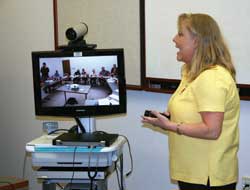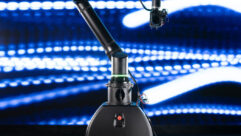

Angels in the Outskirts: Telemedicine in Action
Known as the Antenatal and Neonatal Guidelines, Education, and Learning System (ANGELS), the program employs conferencing technology to virtually transport a medical specialist to wherever the mother and child live and allow the doctor to perform many of the same examinations they would in person.
CHALLENGE: Extend neonatal care and education to people and hospitals throughout the state of Arkansas.
SOLUTION: Employ IP-based videoconferencing and telemedicine, integrated into the unique workflow of a health care system.
Last thing first: in 2007 the american Telemedicine Association bestowed an award on a program run by the University of Arkansas for Medical Sciences (UAMS), in association with the state government and medical society, that contributed to a drop in infant mortality rates in that state’s rural areas and helped lead to increased treatment of low-birth-weight babies and mothers with high-risk conditions.
Known as the Antenatal and Neonatal Guidelines, Education, and Learning System (ANGELS), the program employs conferencing technology to virtually transport a medical specialist to wherever the mother and child live and allow the doctor to perform many of the same examinations they would in person.
“Telemedicine is one of the more challenging verticals for AV, but it’s one of the most rewarding,” says Michael Sanders, regional sales manager for telemedicine at Interactive Solutions (ISI), which worked on the project. “It has a large impact that’s measurable.”
In fact, getting ANGELS to the point where it’s impact could actually be measured took considerable work.
“Our biggest hurdle in this state has always been that we don’t have a single service provider that serves the entire state,” says Eric McKenney, UAMS’s IT manager for video. As a result, the ANGELS program has to tie in each new videconferencing site individually, working with local service providers. Internet protocol can help.
UAMS has been gradually migrating its videoconferencing systems from the older H.320 standard to H.323, which brings with it the ability to transmit over IP networks. Classrooms at affiliated campuses have also been moving to H.323.
In addition to delivering care to rural areas, ANGELS employs custom videoconferencing carts to train specialists.
Credit: Courtesy UAMS
The university started with Polycom multipoint conferencing units (MCUs), but now has several Tandberg 4520 MCUs. The Border Controller and Gateway from Codian, a company Tandberg later acquired, provides firewall traversal so participants outside the UAMS network aren’t stymied by its network protection.
McKenney says the group is testing another Tandberg appliance, the Video Communication Server (VCS), which supports a newer standard called Session Initiation Protocol (SIP) that is more interoperable with other standards and has more features than H.323. “The VCS will give us registration redundancy,” McKenney says, adding that some conferencing participants connect from legacy equipment that won’t register their user information with UAMS’ Codian hardware.
Cartography
In the hospitals, as is the case with many telemedicine systems, ANGELS is built around mobile carts that hold AV, conferencing, and medical hardware. UAMS started out with standard vendor carts, but commissioned ISI, a Memphis integrator, to make custom carts.
“Doctors are used to specialized instruments for each specialty, and they like the telemedicine carts to reflect that,” says ISI’s Sanders, who has helped develop carts for pediatrics, OB/GYN, genetics, and geriatrics. He says the challenge was to build units that were both generic and capable of easily accommodating specialized equipment. The risk of coming into contact with bodily fluids also requires cart equipment to be waterproof. Connectivity is not a problem thanks to wide use of standards such as DVI. “Rarely do you run into something that’s proprietary,” Sanders says.
The carts were also designed for easy integration into auditoriums and other teaching spaces. Sanders says each one has a distribution amplifier that allows the VGA output on the cart’s laptop computer to be split. “It’s a way to quickly get videoconferencing to a room,” he says.
Equipment List
- AMX NI-3000 NetLinx controller with ISCNet option card
- AMX NXD-1200V 12-inch Modero videowall/flush-mount touch panel
- ClearOne Converge Pro 840T
- Elmo EV-4400AF document camera
- 3 42-inch LG 42PM1M-UC displays
- Revolabs Solo Microphone EX
- Sanyo projector
- Tandberg PrecisionHD camera
- Tandberg 6000 MXP codec
- Tandberg 6000 MXP Natural Presenter Package
- Tandberg Audio Science ceiling microphones
Source: Interactive Solutions Inc.
— Below is a list of the equipment installed by Interactive Solutions for the main ANGELS distance learning conference room.
ANGELS also extends beyond one-to-one conferencing between doctors and patients. It encompasses ongoing learning and collaboration–all the way into operating rooms, which are hostile environments for AV. Perhaps the biggest issue can be calculating camera and display angles in close quarters, accommodating the needs of both in-room and remote participants. “The line of sight is usually very difficult,” Sanders says. “You have to get really creative.” So ISI uses another vendor’s telescoping arm to position the cameras.
Audio is another problem, with doctors having side conversations and machines beeping. Sanders says each room requires its own solution–perhaps lip microphones for surgeons, lapel mics for others, or a ceiling mic attached to a light.
With human factors such as these playing such a large role in design, ISI spent much of its time on the front end asking users about their needs and analyzing their workflows. “Instead of changing the day-to-day operations, you’re just supplementing it or enhancing it,” Sanders says.
Angels in the Outskirts: Telemedicine in Action
Known as the Antenatal and Neonatal Guidelines, Education, and Learning System (ANGELS), the program employs conferencing technology to virtually transport a medical specialist to wherever the mother and child live and allow the doctor to perform many of the same examinations they would in person.
Training Days
In another dimension of ANGELS, UAMS recently opened the two-story I. Dodd Wilson Education Building, which required extensive AV in two near-identical auditoriums, six classrooms, and two “double” classrooms, each with a divider. “We’re a very image-oriented industry and campus,” says Ernie Bailey, UAMS’s director of audiovisual services, a department staffed with eight full-time professionals.
Sharp LCD projectors typically light the larger rooms–some auditoriums hold up to 330 people–while Panasonic DLP models tend to go where the material requires accurate motion. Bailey likes to err on the side of brightness when choosing projector lamps, and has been buying nothing but HD models since last year. Most of the large spaces have videoconferencing units and AMX control equipment.
AMX systems distribute videoconferencing signals from the various rooms over a fiber-optic backbone to a central control room for further distribution throughout campus and to remote sites. Coaxial cabling, not Cat-5, handles video distribution because at the time the building was laid out, Bailey wasn’t convinced Cat-5 was ready.
“Our program really focuses on the education of providers,” says Tina Benton, program director for ANGELS. With the ISI carts and other equipment, students can see live data of pregnant mothers and their fetuses, as well as newborns. “We can actually do teaching conferences and fetal monitoring with students, nurses, and faculty,” Benton says. “We can look at fetal monitors for signs of distress.”
A project manager in the UAMS Center for Distance Health trains students on using videoconferencing equipment.
Credit: Courtesy UAMS
McKenney says telemedicine has reduced instructor travel costs. “Our professors can be at any university in the state and talk to any other part of the state,” he says.
In late spring, ISI was working to upgrade a conference room that ANGELS founder Dr. Curtis Lowery will use for conferences. The room has two 42-inch LG flat-panel displays up front, another in the rear, a ceiling-mounted Sanyo projector, two video cameras, a document camera, and a wall-mounted 12-inch AMX Modero touch panel. A Tandberg 6000 MXP codec handles videoconferencing, while a ClearOne ConvergePro 840T provides sound reinforcement for both the remote conferees and the people trying to hear each other in the room. Local participants use Revolabs Solo wireless and tabletop boundary mics.
“The hardest part, from an AV point of view, is it’s an odd room,” Sanders says. The placement of bookcases and windows made it tricky to locate cables and equipment. “We had to accommodate a large group of people in a small area, which is almost more difficult than a larger room with fewer people.” (ISI technicians brought in actual people to simulate room scenarios and get the settings right.)
ISI is also planning to outfit an interactive consultation room that will allow doctors to pull VGA feeds from three separate ultrasound machines. A doctor will be able to view all three rooms and a videoconference on a single, 40-inch AMX TPI-Pro touch screen.
In the end, Lowery’s conference room will be the icing on a cake that will admittedly evolve with new technology. For his part, Sanders appreciates working with a client like UAMS on projects such as ANGELS. He shares the vision of Lowery and other telemedicine proponents: “One day location will have no effect on a patient’s ability to receive the care they need.”









